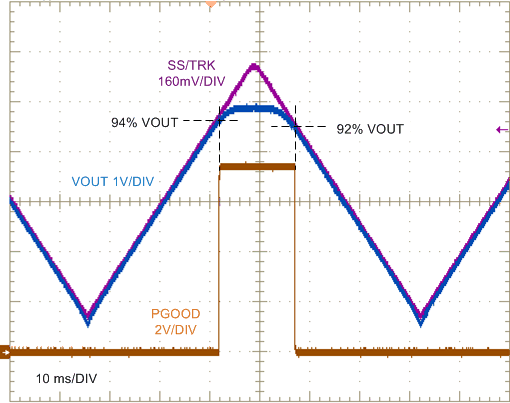SNVSCJ1 August 2023 LV5144
PRODUCTION DATA
- 1
- 1 Features
- 2 Applications
- 3 Description
- 4 Revision History
- 5 Description (continued)
- 6 Pin Configuration and Functions
- 7 Specifications
-
8 Detailed Description
- 8.1 Overview
- 8.2 Functional Block Diagram
- 8.3
Feature Description
- 8.3.1 Input Range (VIN)
- 8.3.2 Output Voltage Setpoint and Accuracy (FB)
- 8.3.3 High-Voltage Bias Supply Regulator (VCC)
- 8.3.4 Precision Enable (EN/UVLO)
- 8.3.5 Power Good Monitor (PGOOD)
- 8.3.6 Switching Frequency (RT, SYNCIN)
- 8.3.7 Configurable Soft Start (SS/TRK)
- 8.3.8 Voltage-Mode Control (COMP)
- 8.3.9 Gate Drivers (LO, HO)
- 8.3.10 Current Sensing and Overcurrent Protection (ILIM)
- 8.3.11 OCP Duty Cycle Limiter
- 8.4 Device Functional Modes
- 9 Application and Implementation
- 10Device and Documentation Support
- 11Mechanical, Packaging, and Orderable Information
Package Options
Mechanical Data (Package|Pins)
- RGY|20
Thermal pad, mechanical data (Package|Pins)
- RGY|20
Orderable Information
8.3.7.1 Tracking
The SS/TRK pin also doubles as a tracking pin when primary-secondary power-supply tracking is required. This tracking is achieved by simply dividing down the output voltage of the primary with a simple resistor network. Coincident, ratiometric, and offset tracking modes are possible.
If an external voltage source is connected to the SS/TRK pin, the external soft-start capability of the LV5144 is effectively disabled. The regulated output voltage level is reached when the SS/TRK pin reaches the 0.8-V reference voltage level. It is the responsibility of the system designer to determine if an external soft-start capacitor is required to keep the device from entering current limit during a start-up event. Likewise, the system designer must also be aware of how fast the input supply ramps if the tracking feature is enabled.
 Figure 8-6 Typical Output Voltage Tracking and PGOOD Waveforms
Figure 8-6 Typical Output Voltage Tracking and PGOOD WaveformsFigure 8-6 shows a triangular voltage signal directly driving SS/TRK and the corresponding output voltage tracking response. Nominal output voltage here is 5 V, with oscilloscope channel scaling chosen such that the waveforms overlap during tracking. As expected, the PGOOD flag transitions at thresholds of 94% (rising) and 92% (falling) of the nominal output voltage setpoint.
Two practical tracking configurations, ratiometric and coincident, are shown in Tracking Implementation With Primary, Ratiometric Secondary, and Coincident Secondary Rails. The most common application is coincident tracking, used in core versus I/O voltage tracking in DSP and FPGA implementations. Coincident tracking forces the primary and secondary channels to have the same output voltage ramp rate until the secondary output reaches its regulated setpoint. Conversely, ratiometric tracking sets the output voltage of the secondary to a fraction of the output voltage of the primary during start-up.
 Figure 8-7 Tracking Implementation With
Primary, Ratiometric Secondary, and Coincident Secondary Rails
Figure 8-7 Tracking Implementation With
Primary, Ratiometric Secondary, and Coincident Secondary RailsFor coincident tracking, connect the SS/TRK input of the secondary regulator to a resistor divider from the output voltage of the primary that is the same as the divider used on the FB pin of the secondary. In other words, simply select RTRK3 = RFB3 and RTRK4 = RFB4 as shown in Tracking Implementation With Primary, Ratiometric Secondary, and Coincident Secondary Rails. As the primary voltage rises, the secondary voltage rises identically (aside from the 80-mV offset from SS/TRK to FB when VFB is below 0.8 V). Eventually, the secondary voltage reaches its regulation voltage, at which point the internal reference takes over the regulation while the SS/TRK input continues to 115 mV above FB, and no longer controls the output voltage.
In all cases, to ensure that the output voltage accuracy is not compromised by the SS/TRK voltage being too close to the 0.8-V reference voltage, the final value of the SS/TRK voltage of the secondary must be at least 100 mV above FB.